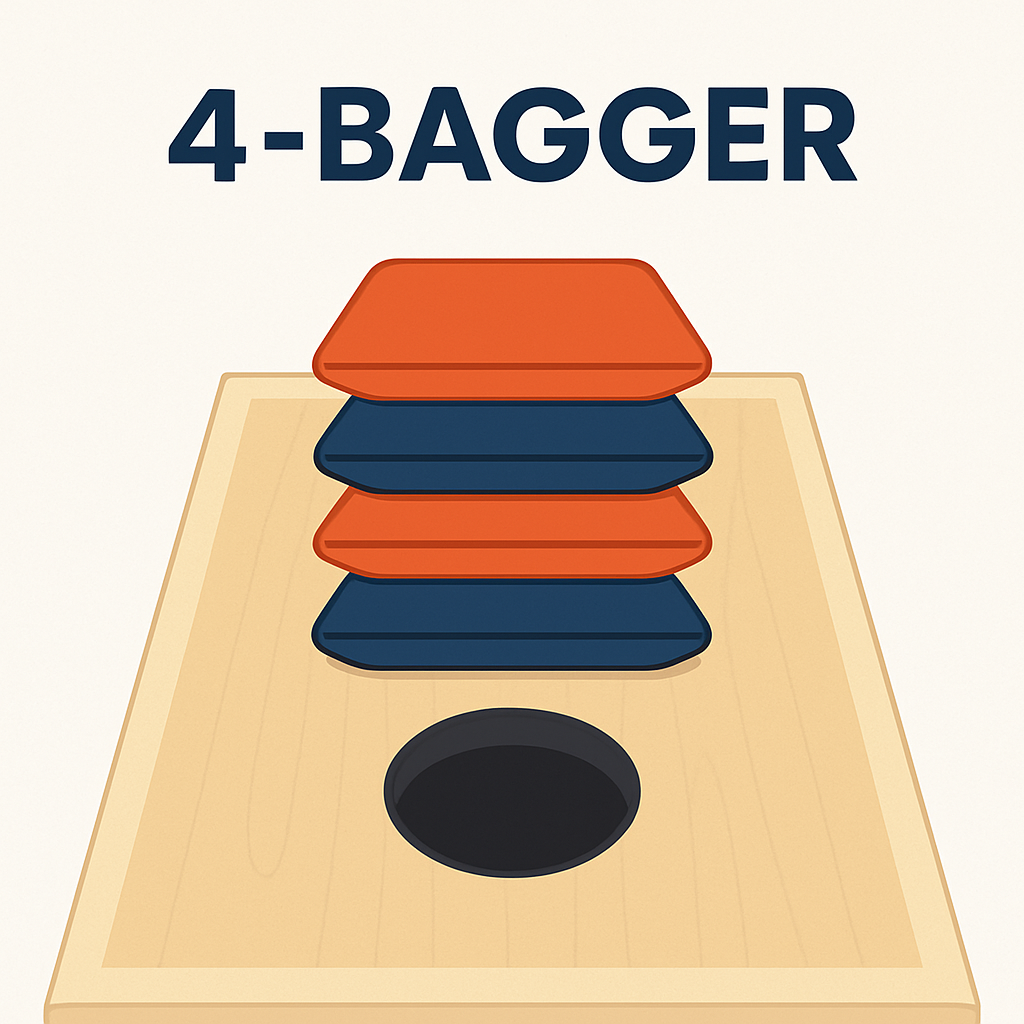How to Throw a 4-Bagger in Cornhole

In the world of cornhole, few achievements feel more satisfying than landing a 4-bagger — that’s when you sink all four of your bags in the hole during a single round. It’s a rare and impressive feat that sets apart casual backyard players from seasoned competitors. Professional players often measure consistency by how many 4-baggers they can string together, and if you’re aiming to sharpen your skills, this is the gold standard.
While it might sound simple—just toss four bags into a hole—anyone who has played knows it’s far from easy. Achieving a 4-bagger requires a mix of proper mechanics, mental focus, strategy, and plenty of practice. In this post, we’ll break down what goes into throwing the perfect 4-bagger and how you can start working toward one yourself.
What is a 4-Bagger?
Before diving into technique, let’s be clear on the definition. A 4-bagger occurs when a player throws all four of their bags into the hole in a single inning. Scoring-wise, that gives you 12 points. But in cornhole, scoring is done using the cancellation method, meaning your total score depends on what your opponent throws as well. Still, the 4-bagger is the benchmark for accuracy and consistency in the game.
In professional play, players like Mark Richards, Jamie Graham, and Matt Guy are known for their ability to string together multiple 4-baggers in a row, which is often the difference between winning and losing at the highest level.
Step 1: Dial in Your Stance
Your stance is the foundation of a consistent throw. Players typically stand inside the designated pitcher’s box with one foot planted firmly and the other positioned for balance. Some prefer a staggered stance, with their lead foot slightly forward, while others stand square to the board. The key is comfort and repeatability.
- Stay balanced: Your weight should shift smoothly from your back foot to your front foot as you release.
- Pick a routine: Develop a pre-shot routine that helps you reset and stay consistent with each throw.
Step 2: Grip and Bag Control
How you hold the bag influences the rotation and stability of your throw. Most players aim for a flat, consistent spin that allows the bag to slide straight toward the hole.
- Flat grip: Hold the bag with your fingers spread evenly underneath and your thumb resting on top.
- Consistent release: You want the bag to leave your hand spinning flat like a frisbee, not wobbling.
- Feel the bag: Different bags have slick and sticky sides—learn how each side plays and adjust for the conditions.
Step 3: Perfecting the Throwing Motion
A smooth, repeatable throwing motion is what separates top players from weekend tossers. Think of it as a pendulum swing.
- Start with the bag in front of you.
- Bring your arm back in a controlled motion, keeping it straight.
- Swing forward smoothly, releasing the bag at the peak of your stride.
- Follow through naturally, with your fingers pointing toward the target.
Consistency here is crucial. Your arm angle, wrist flick, and release point all need to be the same every time. Small variations can send your bag off course.
Step 4: Aim Small, Miss Small
Aiming for the entire board is too broad. Instead, train yourself to focus on a small target point. Many pros aim for the front lip of the hole, knowing that a flat, sliding bag will carry over into the hole. Others prefer to aim directly at the center, trusting their throw to keep it straight.
- Visualize the path: Before you throw, see the bag sliding into the hole.
- Commit to the spot: Don’t second-guess mid-throw. Trust your mechanics.
Step 5: Adjusting for Conditions
No two boards or playing environments are identical. Humidity, temperature, and the type of bags you’re using can all affect how your throw reacts.
- Fast boards: If the boards are slick, you may need to take some speed off your throw.
- Sticky boards: Add a bit more power to ensure your bag reaches the hole.
- Wind: When playing outdoors, lower your arc slightly to reduce the effect of the wind.
Learning to adapt quickly is part of what makes professional players so dangerous.
Step 6: Building Mental Toughness
Throwing one or two bags in the hole feels great, but keeping the focus to land all four is where the challenge lies. A 4-bagger is as much mental as it is physical.
- Stay present: Don’t get ahead of yourself after hitting the first two or three bags. Each throw deserves your full attention.
- Routine under pressure: A consistent pre-shot routine calms nerves and blocks out distractions.
- Confidence matters: Believe in your throw. Doubt leads to tension, and tension leads to misses.
Step 7: Practice With Purpose
A 4-bagger won’t come by accident—you need deliberate practice. Instead of just throwing bags casually, set up drills that mimic game situations.
- 4-Bagger drill: Challenge yourself to hit all four bags in the hole. Track your progress.
- Consecutive streaks: See how many 4-baggers you can hit in a row.
- Pressure practice: Simulate game pressure by setting goals—if you don’t hit three out of four in the hole, start over.
The more you practice with intent, the more natural it becomes when the pressure is real.
Final Thoughts
Throwing a 4-bagger in cornhole is the ultimate combination of mechanics, focus, and mental toughness. It’s not just about tossing bags—it’s about developing a repeatable process, adjusting for conditions, and trusting your skills under pressure. Whether you’re a casual player looking to impress your friends at the next backyard barbecue or an aspiring pro chasing consistency, chasing that perfect round will elevate your game.
And remember, even the best players in the world miss. What sets them apart is how often they can repeat success. So, grab your bags, step up to the board, and start chasing your own 4-bagger streak.
